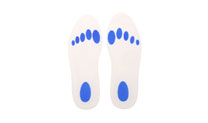For health reasons, many people with foot dysplasia need custom
orthopedic insoles to relieve discomfort during standing or exercising. Traditional orthopedic insoles have a long supply chain and many communication links among users, doctors and manufacturers. Due to the combination of mechanical and manual manufacturing methods, insoles may need to be adjusted and tried on many times before being delivered to users.
However, using 3D printing to customize orthotic insoles will make all the difference. What are the differences? First, let's look at the traditional supply chain of orthotic insoles.
Traditional Supply Chain of Orthopedic Insoles
Traditional manufacture of orthotic insoles usually adopts a combination of mechanical processing and manual processing. In the manufacturing process, it is necessary to have a certain stock of cork, plastic, leather and other major components.
In the traditional mode, users need to communicate with doctors and
insole manufacturers for many times to customize a pair of orthotic insoles. The doctor needs to keep an impression of the user's foot and then provide the impression and design data to the manufacturer. After receiving the information, the manufacturer uses a numerical control machine to process the insole.
The manufacturer gives the manufactured insole to the doctor so as to arrange the user to try it on. Most users often need to modify insoles. In this case, the insole will be returned to the manufacturer for optimization. The whole manufacturing process takes about 4 - 6 weeks.
3D Printing Supply Chain
Doctors obtain user's foot data by using three-dimensional scanning and then provide the scanned data to designers. The designer models and optimizes the design according to the scanning data, so that the foot data of the user and the insole can be adequately fitted. The design data is submitted to a 3D printer to print the insole. There is no fixed location of 3D printer. It can be a manufacturer's 3D printer, a hospital's 3D printer, or even a 3D printer near the user.
The user can complete the free scan through the foot scanner in a few minutes. The soft gel pad on the scanner can accurately capture the three-dimensional shape and pressure point of the foot. Foot data will be sent to customers via email within 5 minutes. After obtaining basic foot and health data, if the user determines to order a pair of
3D printed insoles, the
insole manufacturer company will start designing insoles for the user. The insole will be printed by a 3D printer after the design documents are completed.
In the whole process, from foot scanning to insole design and printing, customers will be notified of every step, and even can view the printing process of insoles through the web camera.
With the help of 3D scanning and 3D printer, the production process of
custom insoles, which once took weeks to complete, has been shortened greatly. With the help of digital technologies such as scanners and CAD software, the design of insoles has become more accurate.

